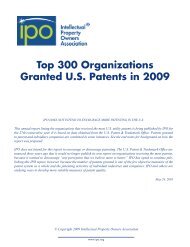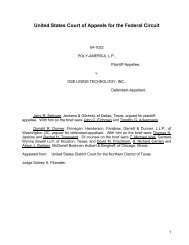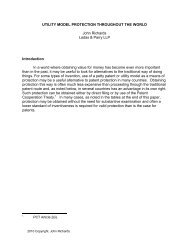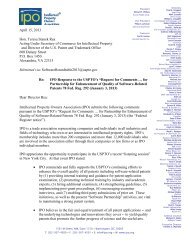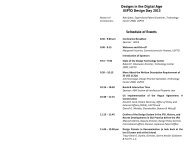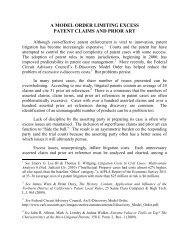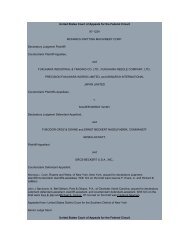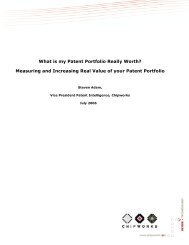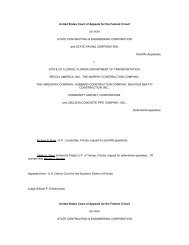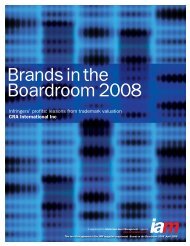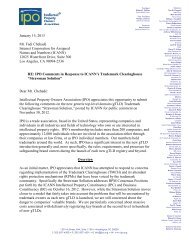comments - Intellectual Property Owners Association
comments - Intellectual Property Owners Association
comments - Intellectual Property Owners Association
You also want an ePaper? Increase the reach of your titles
YUMPU automatically turns print PDFs into web optimized ePapers that Google loves.
July 19, 2013<br />
Hon. Victoria Espinel<br />
<strong>Intellectual</strong> <strong>Property</strong> Enforcement Coordinator<br />
Executive Office of the President<br />
725 17th Street, NW<br />
Washington, DC 20503<br />
Submitted via http://www.regulations.gov<br />
Re: IPEC Review of Exclusion Order Enforcement Processes<br />
Dear Ms. Espinel:<br />
1501 M Street, NW, Suite 1150 ● Washington, DC 20005<br />
T: 202-507-4500 ● F: 202-507-4501 ● E: info@ipo.org ● W: www.ipo.org<br />
President<br />
Richard F. Phillips<br />
Exxon Mobil Corp.<br />
Vice President<br />
Philip S. Johnson<br />
Johnson & Johnson<br />
Treasurer<br />
Carl B. Horton<br />
General Electric Co.<br />
IPO submits the following <strong>comments</strong> in response to the Office of the U.S. <strong>Intellectual</strong> <strong>Property</strong><br />
Enforcement Coordinator's request for written submissions from the public, which was<br />
published in 78 Fed. Reg. 37242 (June 20, 2013), regarding procedures and practices used to<br />
enforce exclusion orders issued by the International Trade Commission. As requested, we<br />
provide this input through responses to the questions set forth in the notice, as follows.<br />
1. Please describe your, positive or negative, experience with the exclusion order<br />
enforcement process.<br />
This question is not applicable to IPO.<br />
2. Are the procedures, criteria, and regulations utilized by CBP when enforcing exclusion<br />
orders clear, accessible, and understood?<br />
The procedures and criteria used by U.S. Customs and Border Protection to enforce exclusion<br />
orders are inadequate, unpredictable, rely excessively on ex parte contacts with Customs<br />
officials, and are difficult to understand.<br />
The only Customs regulation addressing exclusion orders, 19 C.F.R. § 12.39, provides no<br />
guidance to importers regarding what procedures should be followed to determine whether an<br />
article is covered by an exclusion order. The last Customs Directive regarding exclusion orders,<br />
Customs Directive No. 2310-006A, is over 13 years old, adds only a minimum amount of clarity<br />
to the process, and does not have the force and effect of a regulation. The weaknesses of the<br />
current enforcement procedures fall into four general categories.<br />
First, the procedures used by CBP to enforce exclusion orders have changed multiple times in<br />
recent years, making it difficult to understand how CBP will determine whether a product<br />
should be excluded. In the past, CBP relied heavily on written protest decisions and ruling<br />
letters under 19 C.F.R. Parts 174 and 177 to explain its determinations of whether imported<br />
articles fell within the scope of ITC exclusion orders. Today, CBP appears to rely on unwritten<br />
informal determinations and self-certification by importers that the importers are in compliance<br />
with ITC exclusion orders, using Centers of Excellence and Expertise to make its determinations.<br />
None of these changes is reflected in CBP regulations, leading to confusion and uncertainty for<br />
ITC litigants in determining how exclusion orders will be enforced. The circumstances under<br />
Directors<br />
Tina M. Chappell<br />
Intel Corp.<br />
Mark Costello<br />
Xerox Corp.<br />
William J. Coughlin<br />
Ford Global Technologies LLC<br />
Robert DeBerardine<br />
Sanofi-Aventis<br />
Gerald L. DePardo<br />
The Travelers Companies, Inc.<br />
Anthony DiBartolomeo<br />
SAP AG<br />
Bart Eppenauer<br />
Microsoft Corp.<br />
Louis Foreman<br />
Enventys<br />
Scott M. Frank<br />
AT&T<br />
Darryl P. Frickey<br />
Dow Chemical Co.<br />
Bernard J. Graves, Jr.<br />
Eastman Chemical Co.<br />
Krish Gupta<br />
EMC Corporation<br />
Henry Hadad<br />
Bristol-Myers Squibb Co.<br />
Jack E. Haken<br />
Koninklijke Philips N.V.<br />
Alan W. Hammond<br />
Life Technologies Corp.<br />
Dennis R. Hoerner, Jr.<br />
Monsanto Co.<br />
Michael Jaro<br />
Medtronic, Inc.<br />
Lisa Jorgenson<br />
STMicroelectronics, Inc.<br />
Charles M. Kinzig<br />
GlaxoSmithKline<br />
David J. Koris<br />
Shell International B.V.<br />
Allen Lo<br />
Google Inc.<br />
Timothy F. Loomis<br />
Qualcomm, Inc.<br />
Scott McDonald<br />
Mars Incorporated<br />
Steven W. Miller<br />
Procter & Gamble Co.<br />
Douglas K. Norman<br />
Eli Lilly and Co.<br />
Elizabeth A. O’Brien<br />
Covidien<br />
Sean O’Brien<br />
United Technologies, Corp.<br />
Dana Rao<br />
Adobe Systems Inc.<br />
Kevin H. Rhodes<br />
3M Innovative Properties Co.<br />
Mark L. Rodgers<br />
Air Products & Chemicals, Inc.<br />
Curtis Rose<br />
Hewlett-Packard Co.<br />
Matthew Sarboraria<br />
Oracle USA, Inc.<br />
Manny Schecter<br />
IBM, Corp.<br />
Steven Shapiro<br />
Pitney Bowes Inc.<br />
Dennis C. Skarvan<br />
Caterpillar Inc.<br />
Russ Slifer<br />
Micron Technology, Inc.<br />
Terri H. Smith<br />
Motorola Solutions, Inc.<br />
Daniel J. Staudt<br />
Siemens Corp.<br />
Brian K. Stierwalt<br />
ConocoPhillips<br />
Thierry Sueur<br />
Air Liquide<br />
James J. Trussell<br />
BP America, Inc.<br />
Roy Waldron<br />
Pfizer, Inc.<br />
Michael Walker<br />
DuPont<br />
BJ Watrous<br />
Apple Inc.<br />
Stuart Watt<br />
Amgen, Inc.<br />
Paul D. Yasger<br />
Abbott Laboratories<br />
Mike Young<br />
Roche Inc.<br />
General Counsel<br />
Michael D. Nolan<br />
Milbank Tweed<br />
Executive Director<br />
Herbert C. Wamsley
INTELLECTUAL PROPERTY OWNERS ASSOCIATION<br />
which CBP will allow importation of articles upon certification of non-infringement by an<br />
importer is entirely unclear.<br />
Second, the procedures used by CBP to implement ITC exclusion orders lack transparency.<br />
Importers and successful ITC complainants often meet ex parte with CBP officials to educate<br />
CBP regarding what products should be, or should not be, excluded under a given order. These<br />
meetings, however, are informal and off the record. The opposing ITC party is not informed<br />
that its adversary has met with CBP or what has been said. Determinations are often made<br />
without interested parties receiving notice that an issue is under consideration. For example, if<br />
CBP suspects that certain products are in violation of an exclusion order, CBP currently does not<br />
contact the ITC complainant (the rights holder) to seek input on whether the product is in<br />
violation. The rights holder understands the technology and the patents and could provide<br />
valuable input to allow CBP to efficiently make its initial determination. This lack of<br />
transparency leads to uncertainty regarding what might be excluded and why.<br />
Third, CBP's sole reliance on the literal language of ITC exclusion orders (coupled with at best a<br />
limited review of the ITC record) – rather than formal collaboration with the ITC – creates great<br />
uncertainty as to the effective scope of exclusion orders. ITC exclusion orders state only that<br />
they cover products “that infringe" or are "covered by" certain patent claims. The orders,<br />
therefore, are not sufficient for CBP to determine whether imported articles should be excluded<br />
from the United States, and provide no criteria for CBP to apply in enforcing an exclusion order.<br />
It is imperative that CBP and the ITC work closely together to enforce exclusion orders.<br />
Fourth, CBP's current regulations provide no guidance as to how it determines whether<br />
incoming articles fall within the scope of an ITC exclusion order. It is unclear what criteria CBP<br />
use to determine whether a given product infringes or is covered by a patent listed in an<br />
exclusion order.<br />
The ultimate consequence of this lack of clarity in CBP regulations and procedures is that<br />
successful ITC complainants are effectively required – with no due process or predictability – to<br />
re-litigate the ITC investigation in order to ensure proper enforcement. Respondents have no<br />
predictable or transparent process by which to have a determination made as to whether new or<br />
redesigned articles fall within the scope of an ITC exclusion order. The current state of affairs<br />
interferes with legitimate commerce and imposes high costs and uncertainty on the parties.<br />
a. Please provide recommendations for enhancements to procedures, criteria, and<br />
regulations used during enforcement of exclusion orders.<br />
IPO recommends that CBP be required to notify the successful ITC complainant (the rights<br />
holder) when it encounters products that it suspects are in violation of an exclusion order.<br />
Further, CBP should be given the option of providing photos, samples or other relevant<br />
information about the products to the rights holder to seek input about whether there is a<br />
violation. Input from the rights holder at this initial stage would give CBP significant additional<br />
information and allow it to more efficiently make its initial determinations.<br />
IPO also recommends that the ITC take an active role in the interpretation necessary to<br />
effectively enforce its exclusion orders, rather than leaving the responsibility to CBP, which was<br />
not involved in the underlying investigation. At a minimum, the ITC must provide more explicit<br />
and prescriptive guidance to CBP regarding what its orders cover, either within the orders<br />
themselves or by taking an expanded role in enforcement, or preferably both.<br />
- 2 -
INTELLECTUAL PROPERTY OWNERS ASSOCIATION<br />
Above all, IPO recommends that determinations regarding whether products and features<br />
that have not been considered by the ITC infringe a given patent should be made by the<br />
ITC, rather than imposing that burden on CBP. The ITC, having conducted the initial<br />
investigation, is in a much better position to efficiently analyze (a) whether a product or feature<br />
was, in fact, adjudicated at the ITC; and (b) if not, whether that new product or feature avoids<br />
infringement of the patent claims at issue. Moreover, the ITC, because it has authority to issue<br />
and enforce protective orders, allows for a more transparent process between the parties. The<br />
ITC's existing framework also provides significant procedural protections, including adversarial<br />
due process and review by the United States Court of Appeals for the Federal Circuit.<br />
The ITC should make clear what its exclusion orders cover. This requires that the ITC abandon<br />
its practice of defining products covered by an exclusion order as any "that infringe" or that are<br />
"covered by" certain patent claims. We recognize that the purpose of such broad language is to<br />
ensure that parties do not avoid coverage due to minor changes to products or by introducing<br />
new products with the same features. However, the resulting lack of clarity has had a negative<br />
effect on both complainants and importers. The ITC could make much clearer that its exclusion<br />
orders cover the particular products found to infringe and any other products that contain the<br />
same or substantially similar features. Without relying on model numbers, which are easily<br />
changed, the ITC could provide practical guidance to the parties and CBP on how to identify<br />
infringing features, preferably in language that is not excessively technical.<br />
Greater clarity in the drafting of exclusion orders, and practical enforcement instructions from<br />
the ITC, would give CBP a better understanding of what it should exclude and what both sides<br />
must demonstrate in order to ensure that a product is not wrongly excluded or allowed to enter.<br />
The ITC's current orders leave unanswered how infringement should be determined, and by<br />
whom.<br />
CBP's regulations should also make clear which entity within CBP is responsible for<br />
determining whether an imported product is covered by an order, and through what process such<br />
a determination is made. Critically, the process CBP uses, or chooses to use in the future,<br />
should be clearly defined by regulation and should be made transparent.<br />
2. Are the procedures and criteria used by CBP to evaluate the scope of an exclusion order<br />
effective and clearly understood?<br />
As discussed in response to Question 2, above, IPO is not aware of a formal procedure by which<br />
CBP determines the scope of an exclusion order. Because current exclusion orders contain<br />
broad language covering all products that infringe a given patent, scope determinations<br />
necessarily involve complex questions of patent claim interpretation and application to complex<br />
products. CBP does not have a clear, effective way of making these complex determinations,<br />
nor should it be expected to. In the circumstances where courts have held CBP must make such<br />
determinations, such as the application of a general exclusion order to a non-respondent’s<br />
product, CBP should seek, and the ITC should provide, input on these issues.<br />
As noted above, questions regarding scope, as opposed to enforcement, should be resolved by<br />
the ITC. The ITC not only has familiarity with the patents and technology involved, it has a<br />
procedural mechanism to make such complex legal and factual determinations. An exclusion<br />
order itself, or the opinion that accompanies it, should make clear what products and features it<br />
covers. Under the current system, it is clear only that the orders are intended to cover products<br />
that infringe the relevant patent, but not how determinations of infringement are to be made.<br />
- 3 -
INTELLECTUAL PROPERTY OWNERS ASSOCIATION<br />
a. If not, please provide a description of the problem experienced?<br />
Not applicable to IPO.<br />
b. What improvements could be made to the procedures and criteria used by CBP<br />
when evaluating the scope of an exclusion order to assist with the determining<br />
whether an import is covered by the claims of the infringing patent?<br />
As noted above, the ITC, as the entity that conducted the initial infringement determination, is<br />
better situated to answer complex questions of patent infringement.<br />
CBP's current procedure has two fundamental flaws. First, they lack transparency. In particular,<br />
CBP's interpretation of the Trade Secrets Act prevents it from sharing information regarding<br />
meetings or communications with importers or rights holders regarding patent claim scope or<br />
infringement. An interested party, therefore, does not know whether or what the opposing party<br />
is saying regarding patent claim coverage, depriving that party of the opportunity to rebut<br />
arguments made to CBP, and depriving CBP of the benefit of an adversarial decision-making<br />
process. Moreover, the procedure does not require an explanation of CBP’s decision. There<br />
may be no record of the decision. A significant improvement in the process for determining<br />
whether an import is covered by the infringing patent could be achieved by simply giving CBP<br />
the ability to send photos, samples or other relevant information about the import to the<br />
successful ITC complainant (the rights holder) to get input about whether the product is in<br />
violation of the exclusion order.<br />
Second, through the Customs protest procedures specified in 19 U.S.C. § 1514 and 28 U.S.C.<br />
§ 1581, importers can challenge CBP determinations to exclude products, which arguably fall<br />
within the scope of an exclusion order and appeal an adverse protest decision to the CIT.<br />
Significantly, however, ITC complainants that disagree with CBP's infringement<br />
determinations (as opposed to importers) do not have a well-established avenue to protest<br />
CBP's decision or appeal that decision to the CIT. Accordingly, patent owners that invest<br />
significant sums into a successful ITC investigation, and perhaps a successful defense of the ITC<br />
decision on appeal, can be deprived of a meaningful remedy as a result of an ex parte,<br />
unappealable decision by CBP.<br />
c. Under CBP's current ruling request process, 19 CFR Part 177, an importer may seek<br />
a prospective ruling on whether a redesigned or new product falls within the scope<br />
of an exclusion order. Determinations of this kind are often initiated at the request<br />
of the importer (typically the product manufacturer) and are conducted through an<br />
ex parte proceeding. Would development of an inter partes proceeding involving<br />
relevant parties to the ITC investigation enhance the efficiency, transparency and<br />
efficacy of the exclusion order enforcement process with respect to determining the<br />
scope of the exclusion order?<br />
As noted above, the ex parte nature of CBP decision-making regarding scope and enforcement<br />
of exclusion orders creates uncertainty regarding how orders are enforced and interpreted.<br />
Development of an inter partes proceeding would enhance the transparency and fairness of the<br />
process. Notably, however, that inter partes proceeding, if it involves substantive patent<br />
determinations, could be more efficiently conducted by the ITC. The ITC, unlike CBP,<br />
conducts substantive investigations (typically lasting around 18 months) before exclusion orders<br />
- 4 -
INTELLECTUAL PROPERTY OWNERS ASSOCIATION<br />
issue. As a result, the ITC has extensive knowledge of the patents, the technology and the<br />
products at issue before an exclusion order ever reaches CBP.<br />
Moreover, the ITC already has in place a mechanism to consider legal arguments through<br />
briefing, as well as to hold evidentiary hearings if needed. The ITC also has the authority to<br />
issue protective orders and, therefore, to share information with all concerned parties.<br />
Additionally, the ITC also has statutory authority, derived from 19 U.S.C. § 1337(k), to consider<br />
design-arounds and new products.<br />
The ITC, therefore, is already in a position to consider efficiently, transparently, and effectively<br />
new products and/or product features and to make a timely determination regarding whether<br />
those products or features fall within the scope of an exclusion order.<br />
3. Are the processes used by CBP timely and effective in notifying interested parties, for<br />
example, ITC litigants, importers and the general public, of determinations made<br />
regarding the scope of an exclusion order and, in turn, applicability to the imported<br />
product?<br />
IPO is unaware of any formal process used by CBP to notify interested parties of determinations<br />
made regarding the scope of an exclusion order. IPO believes that such a process should, at the<br />
very least, be transparent, seek input from the ITC, include advance public notice that it intends<br />
to consider a particular exclusion order and product, and should result in an appealable decision<br />
regarding whether that product is within the scope of an exclusion order.<br />
4. What further procedural changes or collaborative steps could be undertaken between the<br />
ITC and CBP to improve the efficacy of exclusion order enforcement efforts?<br />
IPO believes that the recommendations outlined above would improve the efficacy of exclusion<br />
order enforcement efforts by placing primary responsibility to define and resolve questions<br />
regarding the scope of exclusion orders with the ITC. Improved communication between the<br />
ITC and CBP, both formal and informal, would also enhance the process. CBP, in turn, could<br />
focus its considerable expertise on enforcement of those orders.<br />
5. Do exclusion orders currently provide sufficient level of detail and direction necessary to<br />
assist CBP with the challenges of enforcement?<br />
As discussed in response to Question 2(a), above, ITC exclusion orders currently do not provide<br />
sufficient detail to meaningfully define their scope. The language currently used by the ITC<br />
requires CBP to make difficult, complex infringement determinations when new products are<br />
presented.<br />
6. Please identify any additional areas of consideration regarding improvements that could<br />
be undertaken by CBP or the ITC to further improve upon the exclusion order<br />
enforcement process.<br />
A model procedural schedule for exclusion order enforcement would help to set expectations for<br />
both complainants and respondents and would help to ensure that the procedural enhancements<br />
proposed above do not expand into a de facto second investigation. CBP or the ITC would have<br />
the ability to modify this schedule to suit the situation.<br />
- 5 -
INTELLECTUAL PROPERTY OWNERS ASSOCIATION<br />
<br />
<br />
<br />
<br />
<br />
Preceding event: CBP initial decision to allow or prevent importation of claimed designaround<br />
product. CBP notifies complainant and importer.<br />
Day 1: Party dissatisfied with CBP’s decision notifies CBP in writing, with a copy to ITC<br />
and opposing party, concisely stating the basis for its disagreement.<br />
Day 6 (i.e., five business days later): Deadline for opposing party to respond.<br />
Day 8: ITC or CBP notify parties whether it will decide the issue on the papers or<br />
schedule a hearing.<br />
Five days after hearing or five days after notification of decision on papers: ITC or CBP<br />
issues a written decision briefly stating the reasons for its ruling.<br />
IPO applauds IPEC’s continuing efforts to include public participation and input in reviewing<br />
possible changes that could improve the enforcement of ITC exclusion orders. We welcome the<br />
opportunity to provide further <strong>comments</strong> and insight as requested in the future.<br />
Sincerely,<br />
Richard F. Phillips<br />
President<br />
- 6 -



